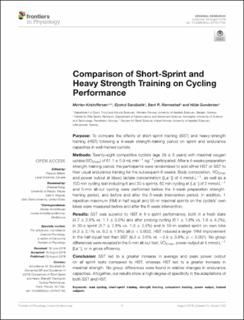| dc.contributor.author | Kristoffersen, Morten | |
| dc.contributor.author | Sandbakk, Øyvind | |
| dc.contributor.author | Rønnestad, Bent | |
| dc.contributor.author | Gundersen, Hilde | |
| dc.date.accessioned | 2020-12-09T08:56:39Z | |
| dc.date.available | 2020-12-09T08:56:39Z | |
| dc.date.created | 2019-10-03T19:07:43Z | |
| dc.date.issued | 2019 | |
| dc.identifier.citation | Frontiers in Physiology. 2019, 10 . | en_US |
| dc.identifier.issn | 1664-042X | |
| dc.identifier.uri | https://hdl.handle.net/11250/2712524 | |
| dc.description | Copyright © 2019 Kristoffersen, Sandbakk, Rønnestad and Gundersen. This is an open-access article distributed under the terms of the Creative Commons Attribution License (CC BY). The use, distribution or reproduction in other forums is permitted, provided the original author(s) and the copyright owner(s) are credited and that the original publication in this journal is cited, in accordance with accepted academic practice. No use, distribution or reproduction is permitted which does not comply with these terms. | en_US |
| dc.description.abstract | Purpose: To compare the effects of short-sprint training (SST) and heavy-strength training (HST) following a 4-week strength-training period on sprint and endurance capacities in well-trained cyclists.
Methods: Twenty-eight competitive cyclists (age 29 ± 6 years) with maximal oxygen uptake (VO˙ 2max) of 61.1 ± 5.9 mL·min−1 ·kg−1 participated. After a 4-weeks preparation strength-training period, the participants were randomized to add either HST or SST to their usual endurance training for the subsequent 6 weeks. Body composition, VO˙ 2max and power output at blood lactate concentration ([La−]) of 4 mmol·L −1 , as well as a 100 min cycling test including 6 and 30-s sprints, 60 min cycling at [La−] of 2 mmol·L −1 and 5-min all-out cycling were performed before the 4-week preparation strengthtraining period, and before and after the 6-week intervention period. In addition, 1 repetition maximum (RM) in half-squat and 55-m maximal sprints on the cyclists’ own bikes were measured before and after the 6-week intervention.
Results: SST was superior to HST in 6-s sprint performance, both in a fresh state (4.7 ± 2.6% vs. 1.1 ± 3.5%) and after prolong cycling (6.1 ± 1.8% vs. 1.8 ± 4.2%), in 30-s sprint (3.7 ± 2.8% vs. 1.3 ± 2.5%) and in 55-m seated sprint on own bike (4.3 ± 2.1% vs. 0.2 ± 1.8%) (all p < 0.002). HST induced a larger 1RM improvement in the half-squat test than SST (9.3 ± 3.6% vs. −3.9 ± 3.8%; p < 0.001). No group differences were revealed in the 5-min all-out test, VO˙ 2max, power output at 4 mmol·L −1 [La−], or in gross efficiency.
Conclusion: SST led to a greater increase in average and peak power output on all sprint tests compared to HST, whereas HST led to a greater increase in maximal strength. No group differences were found in relative changes in endurance capacities. Altogether, our results show a high degree of specificity in the adaptations of both SST and HST. | en_US |
| dc.language.iso | eng | en_US |
| dc.rights | Navngivelse 4.0 Internasjonal | * |
| dc.rights.uri | http://creativecommons.org/licenses/by/4.0/deed.no | * |
| dc.subject | Road cycling | en_US |
| dc.subject | Short-sprint training | en_US |
| dc.subject | Strength training | en_US |
| dc.subject | Concurrent training | en_US |
| dc.subject | Power output | en_US |
| dc.subject | Trained subjects | en_US |
| dc.title | Comparison of Short-Sprint and Heavy Strength Training on Cycling Performance | en_US |
| dc.type | Peer reviewed | en_US |
| dc.type | Journal article | en_US |
| dc.description.version | publishedVersion | en_US |
| dc.subject.nsi | VDP::Medisinske Fag: 700::Idrettsmedisinske fag: 850 | en_US |
| dc.source.pagenumber | 9 | en_US |
| dc.source.volume | 10 | en_US |
| dc.source.journal | Frontiers in Physiology | en_US |
| dc.identifier.doi | 10.3389/fphys.2019.01132 | |
| dc.identifier.cristin | 1733724 | |
| dc.source.articlenumber | 1132 | en_US |
| cristin.unitcode | 209,4,4,0 | |
| cristin.unitname | Idrettshøgskolen Innlandet | |
| cristin.ispublished | true | |
| cristin.fulltext | original | |
| cristin.qualitycode | 1 | |

